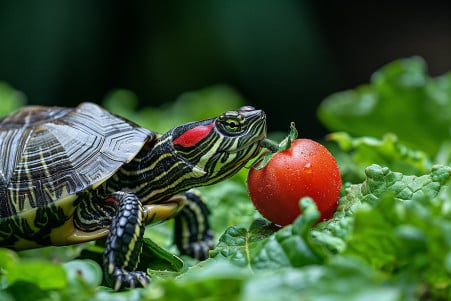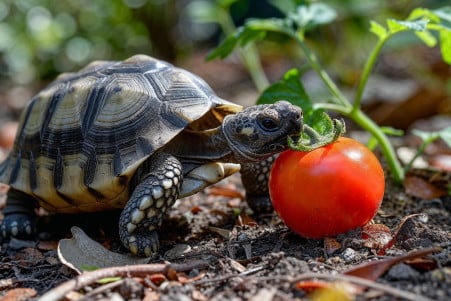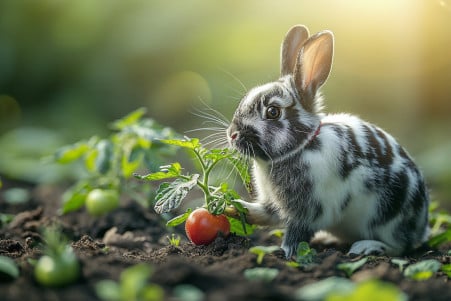Can Birds Have Tomatoes? Everything You Need to Know
15 May 2024 • Updated 14 May 2024

If you've ever wondered whether or not you can give tomatoes to birds, you're not alone. Birds can eat tomatoes, and many even like to eat them because they're good for their health. Tomatoes are a great source of antioxidants, fiber, and a small amount of protein, making them a delicious and nutritious snack that most birds in your backyard will be happy to eat.
That said, while tomatoes can be a healthy part of a bird's diet, there are some things to keep in mind when it comes to ripeness, how they're prepared, and how much you offer. This article covers the most recent findings from ornithologists, veterinarians, and wildlife researchers to help you understand whether tomatoes are safe for birds, how to serve them, and which birds are most likely to eat this fruit.
Can birds eat tomatoes?
Toxic Tomato Plant Parts: Keeping Birds Safe
While the tomato fruit is a healthy and harmless food source for birds, the leaves, stems, and vines of tomato plants contain toxic compounds called glycoalkaloids. Ingesting these parts of the plant can cause extreme gastrointestinal upset, neurological symptoms, and even death in birds according to a discussion on Pigeon-Talk.
Birds can accidentally consume these toxic plant parts while trying to get to the ripe tomatoes or while foraging for insects near the plants. As mentioned by Garden Dreams, some birds, such as garden songbirds, have been seen pecking at the tender leaves of tomato plants, which could put them at risk of exposure.
To keep birds safe, gardeners need to make sure they are taking the right steps. This includes covering or putting up barriers around tomato plants to keep birds from getting to and eating the toxic parts of the plant. Regularly checking plants and removing any damaged or fallen vines and leaves can also help reduce the risk of toxicity. By staying on top of these measures, birds can enjoy the healthy fruit of the tomato plant without the risk of exposure to toxic parts.
Tomato-Loving Birds: Bird Species That Like to Eat Tomatoes
There are specific bird species that are more likely to go after tomatoes from garden plants. These include robins, mockingbirds, cardinals, bluejays, blackbirds, crows, and sparrows. Per BonjourGreen, these birds are attracted to the bright color, juiciness, and high water content of ripe tomatoes.
Meanwhile, some birds, such as hummingbirds, may eat the nectar from tomato flowers. Meanwhile, TomatoInsight explains that knowing which birds like to eat tomatoes can help gardeners choose the best bird control options.
Bird Taste Buds: How Birds Taste Tomatoes
Birds have a complex sense of taste that enables them to assess the nutritional and toxic properties of tomatoes and other foods. According to the Audubon, birds have fewer taste buds than mammals, but their sense of taste is more complex than previously realized.
Research published in PMC has demonstrated that the different types of taste buds in birds have evolved in response to their diets and feeding behaviors. It's possible that birds can taste certain compounds in tomatoes, such as sugars and acids, which would impact their perception of the fruit's flavor. The variation in taste bud types among birds has been linked to the evolution of different diets.
Learning more about the way birds taste and experience the flavor of tomatoes can help explain why they're attracted to the fruit and enable gardeners to protect their tomato plants while still offering birds a safe and appealing food source.
Ready for the Picking: How Birds Detect and Eat Tomatoes
Birds can tell when tomatoes are ripe and ready to eat based on a number of factors. Per TomatoInsight, the bright red color and soft texture of ripe tomatoes are appealing to many birds. Some birds may prefer ripe, soft tomatoes, while others may go after unripe or partially ripe tomatoes.
Per AgriLife Today, birds may also be attracted to the moisture in tomatoes, especially in times of drought or dry weather. Knowing how birds detect and eat tomatoes can help gardeners come up with ways to keep their tomatoes safe.
Nutritional Benefits: Why Tomatoes are a Good Source of Food for Birds
Tomatoes offer birds the nutrients and health advantages they need to help meet their dietary requirements. They are a good source of vitamins A and C, potassium, fiber, and antioxidants, including lycopene. According to VCA Animal Hospitals, yellow, red, and orange vegetables and fruits, like tomatoes, are high in vitamin A, which is an important nutrient for birds.
The nutritional content of tomatoes can change depending on how ripe they are and the type of tomato. Healthline explains that tomatoes are the biggest source of lycopene in the human diet, which has been shown to help lower the risk of certain diseases, including heart disease and cancer. This means that tomatoes that are riper and redder will have more lycopene.
Even though tomatoes have many benefits, they should still be eaten in moderation as part of a well-balanced diet. As pointed out by PetEveryday, the acidity in tomatoes can cause a bird to have an upset stomach, and the seeds and stems of tomatoes have toxins in them that can be dangerous if they are eaten in large amounts. This helps to explain why birds are drawn to tomatoes as a food source.
How to Keep Birds Away From Your Tomato Plants
There are several ways that gardeners can keep birds from eating their tomatoes. Gardening Know How suggests that gardeners use physical barriers like netting, cages, or fencing to keep birds away from their plants. They also recommend using visual and auditory deterrents, such as shiny objects, scarecrows, or noise-making devices.
According to BonjourGreen, gardeners can also plant certain herbs or flowers around their tomato plants to deter birds with their strong scents. In addition, gardeners can reduce the likelihood of birds eating their tomatoes by providing alternative food sources or creating bird-friendly areas in their garden. By using a combination of these methods, gardeners can keep birds from eating their tomatoes while still supporting local bird populations.
Conclusion: Finding a Middle Ground Between Bird-Friendly Gardens and Tomato Protection
Birds have a number of ways to tell when tomatoes are ripe and ready to eat. Per TomatoInsight, the bright red color and soft texture of ripe tomatoes are appealing to many birds. Some birds may even have a preference for ripe, soft tomatoes, while others may go after unripe or partially ripe tomatoes.
As AgriLife Today explains, birds may also be attracted to the water in tomatoes, especially in dry or drought conditions. Knowing how birds detect and consume tomatoes can help gardeners come up with ways to protect their plants.


